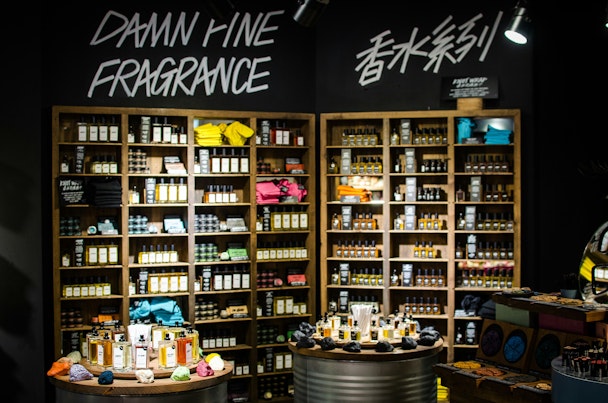Why haven’t social blackouts from Bottega Veneta and Lush spread to other retailers?
Back in 2021, two major retailers made waves by quitting certain social media platforms. But the waves didn’t spread. For The Drum’s retail deep dive, Jamie Ross-Skinner of Roast (part of the Tipi Group) asks why.

Lush's social media blackout: Why did so few follow? / Trung Do Bao via Unsplash
On 26 November 2021, cosmetics retailer Lush turned its back on social media. It quit Facebook, Instagram, and TikTok, saying it wouldn’t return until those platforms provided a safer environment for all users (the brand maintains a presence on X, YouTube, and Pinterest). The marketing world applauded, and many predicted that other brands would join the Lush crusade. But in the end, few did. The Lush campaign, like one of their famous bath bombs, made a brief fizz, then dissolved into insignificance.
Lush, for its part, has doubled down on its ‘anti-social’ commitment and looks set to stick to its guns, but will the sacrifice be worth it?
Advertisement
Purposeful from the start
Lush is a true British business success story. Founded 27 years ago and starting with a small shop in Dorset, it now has over 800 stores worldwide. A key ingredient of its success is a fiercely purposeful way of doing business.
There has been a lot of ‘purpose-bashing’ in the marketing press over the past couple of years, but Lush is a great example of how to do purpose well. Its eco-credentials are deeply ingrained in its DNA, helping to differentiate the brand in a category which has now been flooded with greenwashing.
Lush originally left social media in 2019, stating that it was ‘tired of fighting with algorithms’, but returned to some platforms in 2020 when the pandemic hit, before exiting again in November 2021.
The decision to leave was driven primarily by a belief, supported by Facebook whistleblowers, that social media was damaging the mental health of teens.
Who followed Lush?
The other big story of a brand exiting social entirely was Bottega Veneta, which also quit in 2021. Rather than a strict ‘anti-social’ message, the luxury fashion house put out a statement saying that the brand had decided “to lean much more on its ambassadors and fans by giving them the material they need to talk about the brand through various social networks by letting them speak for the brand rather than doing it itself”.
The statement is arguably not completely clear, but it is certainly not an attack on social per se. It seems Bottega Veneta left social for commercial rather than moral reasons, gambling that due to the absence of an official brand presence, super-fans would fill the void with lovingly-made user-generated content.
It’s a risky strategy, and certainly not one that would transfer easily outside the luxury space. (The brand has since made a minor return to social media, popping up on Chinese app Weibo earlier this year).
Advertisement
The age of social
Lush may well be right that social media does more harm than good in the world. Bottega Veneta may also be right that beloved brands can exist without an ‘official’ page. But for most brands, leaving social is simply too big a risk.
We’re living in an increasingly digital age and whether we like it or not, social media plays a huge role in our lives. Facebook now has a staggering 3 billion users and young people in the UK spend more time on TikTok than watching broadcast TV. According to Ofcom, most children under 13 in the UK have a profile on at least one social media app.
As the first generation of children who grew up fully with social media begin to reach adulthood, we’ve even seen people turning their back on search engines. A Google exec recently stated that “almost 40% of young people, when they’re looking for a place for lunch, they don’t go to Google Maps or Search. They go to TikTok or Instagram”. This shows that for young people, social media is already ‘eating’ the internet. Social is becoming their first port-of-call for tasks that were once far beyond its remit.
And as consumer attention has shifted away from channels like linear TV towards social media, ad spend has followed. WARC has predicted that in Q4 2024 social will overtake search as the largest advertising channel by spend.
Perhaps the ‘age of social’ is only just beginning?
Suggested newsletters for you
2030 vision
We can’t know what the world will be like in 2030, but it’s possible that social media will have matured and taken an even higher share of attention than it does now.
We already see people watching TV on TikTok and social ‘super-apps’ starting to take over in Asia, and there’s no obvious reason this won’t spread throughout the world. Governments will have to step up their regulation, but social apps will almost certainly remain. Not being on social in 2030 might just be the same as not having a website in 2023.
Brands need to connect with the next generation of buyers, and whether you like it or not, the best way to do it is through social.
Get ready for the retail world of the future with more smart thinking and detailed analysis over at our dedicated deep dive hub.
Content by The Drum Network member:

TIPi Group
TIPi Group is an award winning network of specialist digital agencies. Our agencies are built on performance and profitability and share an ambition to use the power...
Find out more
